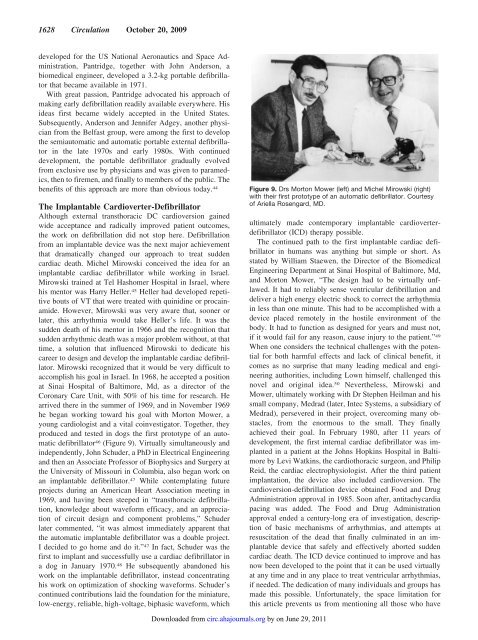Cardioversion Past, Present, and Future - the Laboratory of Igor Efimov
Cardioversion Past, Present, and Future - the Laboratory of Igor Efimov
Cardioversion Past, Present, and Future - the Laboratory of Igor Efimov
You also want an ePaper? Increase the reach of your titles
YUMPU automatically turns print PDFs into web optimized ePapers that Google loves.
1628 Circulation October 20, 2009developed for <strong>the</strong> US National Aeronautics <strong>and</strong> Space Administration,Pantridge, toge<strong>the</strong>r with John Anderson, abiomedical engineer, developed a 3.2-kg portable defibrillatorthat became available in 1971.With great passion, Pantridge advocated his approach <strong>of</strong>making early defibrillation readily available everywhere. Hisideas first became widely accepted in <strong>the</strong> United States.Subsequently, Anderson <strong>and</strong> Jennifer Adgey, ano<strong>the</strong>r physicianfrom <strong>the</strong> Belfast group, were among <strong>the</strong> first to develop<strong>the</strong> semiautomatic <strong>and</strong> automatic portable external defibrillatorin <strong>the</strong> late 1970s <strong>and</strong> early 1980s. With continueddevelopment, <strong>the</strong> portable defibrillator gradually evolvedfrom exclusive use by physicians <strong>and</strong> was given to paramedics,<strong>the</strong>n to firemen, <strong>and</strong> finally to members <strong>of</strong> <strong>the</strong> public. Thebenefits <strong>of</strong> this approach are more than obvious today. 44The Implantable Cardioverter-DefibrillatorAlthough external transthoracic DC cardioversion gainedwide acceptance <strong>and</strong> radically improved patient outcomes,<strong>the</strong> work on defibrillation did not stop here. Defibrillationfrom an implantable device was <strong>the</strong> next major achievementthat dramatically changed our approach to treat suddencardiac death. Michel Mirowski conceived <strong>the</strong> idea for animplantable cardiac defibrillator while working in Israel.Mirowski trained at Tel Hashomer Hospital in Israel, wherehis mentor was Harry Heller. 45 Heller had developed repetitivebouts <strong>of</strong> VT that were treated with quinidine or procainamide.However, Mirowski was very aware that, sooner orlater, this arrhythmia would take Heller’s life. It was <strong>the</strong>sudden death <strong>of</strong> his mentor in 1966 <strong>and</strong> <strong>the</strong> recognition thatsudden arrhythmic death was a major problem without, at thattime, a solution that influenced Mirowski to dedicate hiscareer to design <strong>and</strong> develop <strong>the</strong> implantable cardiac defibrillator.Mirowski recognized that it would be very difficult toaccomplish his goal in Israel. In 1968, he accepted a positionat Sinai Hospital <strong>of</strong> Baltimore, Md, as a director <strong>of</strong> <strong>the</strong>Coronary Care Unit, with 50% <strong>of</strong> his time for research. Hearrived <strong>the</strong>re in <strong>the</strong> summer <strong>of</strong> 1969, <strong>and</strong> in November 1969he began working toward his goal with Morton Mower, ayoung cardiologist <strong>and</strong> a vital coinvestigator. Toge<strong>the</strong>r, <strong>the</strong>yproduced <strong>and</strong> tested in dogs <strong>the</strong> first prototype <strong>of</strong> an automaticdefibrillator 46 (Figure 9). Virtually simultaneously <strong>and</strong>independently, John Schuder, a PhD in Electrical Engineering<strong>and</strong> <strong>the</strong>n an Associate Pr<strong>of</strong>essor <strong>of</strong> Biophysics <strong>and</strong> Surgery at<strong>the</strong> University <strong>of</strong> Missouri in Columbia, also began work onan implantable defibrillator. 47 While contemplating futureprojects during an American Heart Association meeting in1969, <strong>and</strong> having been steeped in “transthoracic defibrillation,knowledge about waveform efficacy, <strong>and</strong> an appreciation<strong>of</strong> circuit design <strong>and</strong> component problems,” Schuderlater commented, “it was almost immediately apparent that<strong>the</strong> automatic implantable defibrillator was a doable project.I decided to go home <strong>and</strong> do it.” 47 In fact, Schuder was <strong>the</strong>first to implant <strong>and</strong> successfully use a cardiac defibrillator ina dog in January 1970. 48 He subsequently ab<strong>and</strong>oned hiswork on <strong>the</strong> implantable defibrillator, instead concentratinghis work on optimization <strong>of</strong> shocking waveforms. Schuder’scontinued contributions laid <strong>the</strong> foundation for <strong>the</strong> miniature,low-energy, reliable, high-voltage, biphasic waveform, whichFigure 9. Drs Morton Mower (left) <strong>and</strong> Michel Mirowski (right)with <strong>the</strong>ir first prototype <strong>of</strong> an automatic defibrillator. Courtesy<strong>of</strong> Ariella Rosengard, MD.ultimately made contemporary implantable cardioverterdefibrillator(ICD) <strong>the</strong>rapy possible.The continued path to <strong>the</strong> first implantable cardiac defibrillatorin humans was anything but simple or short. Asstated by William Staewen, <strong>the</strong> Director <strong>of</strong> <strong>the</strong> BiomedicalEngineering Department at Sinai Hospital <strong>of</strong> Baltimore, Md,<strong>and</strong> Morton Mower, “The design had to be virtually unflawed.It had to reliably sense ventricular defibrillation <strong>and</strong>deliver a high energy electric shock to correct <strong>the</strong> arrhythmiain less than one minute. This had to be accomplished with adevice placed remotely in <strong>the</strong> hostile environment <strong>of</strong> <strong>the</strong>body. It had to function as designed for years <strong>and</strong> must not,if it would fail for any reason, cause injury to <strong>the</strong> patient.” 49When one considers <strong>the</strong> technical challenges with <strong>the</strong> potentialfor both harmful effects <strong>and</strong> lack <strong>of</strong> clinical benefit, itcomes as no surprise that many leading medical <strong>and</strong> engineeringauthorities, including Lown himself, challenged thisnovel <strong>and</strong> original idea. 50 Never<strong>the</strong>less, Mirowski <strong>and</strong>Mower, ultimately working with Dr Stephen Heilman <strong>and</strong> hissmall company, Medrad (later, Intec Systems, a subsidiary <strong>of</strong>Medrad), persevered in <strong>the</strong>ir project, overcoming many obstacles,from <strong>the</strong> enormous to <strong>the</strong> small. They finallyachieved <strong>the</strong>ir goal. In February 1980, after 11 years <strong>of</strong>development, <strong>the</strong> first internal cardiac defibrillator was implantedin a patient at <strong>the</strong> Johns Hopkins Hospital in Baltimoreby Levi Watkins, <strong>the</strong> cardiothoracic surgeon, <strong>and</strong> PhilipReid, <strong>the</strong> cardiac electrophysiologist. After <strong>the</strong> third patientimplantation, <strong>the</strong> device also included cardioversion. Thecardioversion-defibrillation device obtained Food <strong>and</strong> DrugAdministration approval in 1985. Soon after, antitachycardiapacing was added. The Food <strong>and</strong> Drug Administrationapproval ended a century-long era <strong>of</strong> investigation, description<strong>of</strong> basic mechanisms <strong>of</strong> arrhythmias, <strong>and</strong> attempts atresuscitation <strong>of</strong> <strong>the</strong> dead that finally culminated in an implantabledevice that safely <strong>and</strong> effectively aborted suddencardiac death. The ICD device continued to improve <strong>and</strong> hasnow been developed to <strong>the</strong> point that it can be used virtuallyat any time <strong>and</strong> in any place to treat ventricular arrhythmias,if needed. The dedication <strong>of</strong> many individuals <strong>and</strong> groups hasmade this possible. Unfortunately, <strong>the</strong> space limitation forthis article prevents us from mentioning all those who haveDownloaded from circ.ahajournals.org by on June 29, 2011



